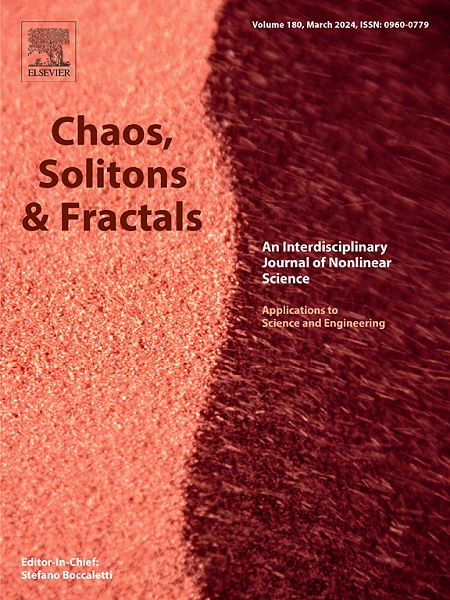时滞反馈多稳定随机共振与综经验模态分解相结合的方法及其在漆丝张力测量中的应用
IF 5.3
1区 数学
Q1 MATHEMATICS, INTERDISCIPLINARY APPLICATIONS
引用次数: 0
摘要
在线测量漆包线张力对于确保生产质量至关重要。然而,微弱的振动信号和严重的噪声干扰给精确的张力测量带来了相当大的挑战。为应对这些挑战,本文提出了一种新方法,将延时反馈多稳态随机共振(TFMSR)与集合经验模式分解(EEMD)相结合,以增强漆包线的微弱振动信号,实现精确的张力测量。首先,将时延反馈项纳入多稳态随机共振模型。通过研究布朗粒子在势阱中的运动,分析了屏障参数、反馈强度、延迟时间和噪声强度对随机共振输出的影响。结果表明,TFMSR 模型能有效地去噪故障信号,提高输出的信噪比,从而为提取漆包线的固有频率奠定了坚实的基础。随后,将所提出的 TFMSR 与 EEMD 方法相结合,与 TFMSR 模型和传统的信号预处理方法进行比较,以提取固有频率。比较结果表明,在准确识别漆包线固有频率方面,建议的方法优于其他方法。最后,实验和工程应用验证了 TFMSR 结合 EEMD 方法在漆包线固有频率提取和张力测量方面的有效性和优越性。总之,所提出的方法在处理微弱信号方面具有显著优势,是碳纤维、聚酯纤维和柔性基材等材料张力测量的理想方法。本文章由计算机程序翻译,如有差异,请以英文原文为准。
Time-delayed feedback multistable stochastic resonance in combination with ensemble empirical mode decomposition method and its application in the measurement of the varnished wire tension
The online measurement of varnished wire tension is essential for ensuring production quality. However, weak vibration signals and significant noise interference pose considerable challenges to accurate tension measurement. To address these challenges, this paper proposes a novel method that combines Time-delayed Feedback Multistable Stochastic Resonance (TFMSR) with Ensemble Empirical Mode Decomposition (EEMD) to enhance the weak vibration signals of varnished wire and achieve precise tension measurement. Initially, a time-delay feedback term is incorporated into a multistable stochastic resonance model. By examining the motion of Brownian particles in a potential well, the effects of barrier parameters, feedback strength, delay time, and noise intensity on the stochastic resonance output are analyzed. The results demonstrate that the TFMSR model effectively denoises fault signals and improves the signal-to-noise ratio of the output, thereby providing a solid foundation for extracting the natural frequency of the varnished wire. Subsequently, the proposed TFMSR in combination with the EEMD method is compared to the TFMSR model and traditional signal preprocessing methods for natural frequency extraction. The comparison reveals that the proposed method outperforms the others in accurately identifying the natural frequencies of the varnished wire. Finally, experimental and engineering applications validate the effectiveness and superiority of the TFMSR in combination with the EEMD method for both natural frequency extraction and tension measurement of varnished wire. In summary, the proposed method demonstrates significant advantages in processing weak signals, making it a promising approach for tension measurement in materials such as carbon fibers, polyester fibers, and flexible substrates.
求助全文
通过发布文献求助,成功后即可免费获取论文全文。
去求助
来源期刊

Chaos Solitons & Fractals
物理-数学跨学科应用
CiteScore
13.20
自引率
10.30%
发文量
1087
审稿时长
9 months
期刊介绍:
Chaos, Solitons & Fractals strives to establish itself as a premier journal in the interdisciplinary realm of Nonlinear Science, Non-equilibrium, and Complex Phenomena. It welcomes submissions covering a broad spectrum of topics within this field, including dynamics, non-equilibrium processes in physics, chemistry, and geophysics, complex matter and networks, mathematical models, computational biology, applications to quantum and mesoscopic phenomena, fluctuations and random processes, self-organization, and social phenomena.
 求助内容:
求助内容: 应助结果提醒方式:
应助结果提醒方式:


